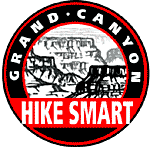|
A permit is required to camp in a location other than a developed campground on the North and South Rims. Visit the Backcountry Permit page to learn how to obtain a permit. Also, read the Backcountry Food Storage and Safe Drinking Water guidelines when planning a backcountry trip. 
HIKE SMART
|
| Code | Use Area Name | Mgmt. Zone | Camping Type |
| AH9 | Vishnu | Wild | At Large Camping |
| AJ9 | Cheyava | Wild | At Large Camping |
| AK9 | Clear Creek | Threshold | At Large Camping |
| AL9 | Greenland Springs | Wild | At Large Camping |
| AP9 | Phantom Creek | Wild | At Large Camping |
| AQ9 | Trinity Creek | Wild | At Large Camping |
| AR9 | Scorpion Ridge | Wild | At Large Camping |
| BE9 | Hance Creek | Primitive | At Large Camping |
| BF5 | Horseshoe Mesa | Threshold | Designated Sites |
| BG9 | Cottonwood Creek | Primitive | At Large Camping |
| BH9 | Grapevine | Primitive | At Large Camping |
| BJ9 | Cremation | Primitive | At Large Camping |
| BL4 | Horn Creek | Threshold | Designated Sites |
| BL5 | Salt Creek | Threshold | Designated Sites |
| BL6 | Cedar Spring | Threshold | Designated Sites |
| BL7 | Monument Creek | Threshold | Designated Sites |
| BL8 | Granite Rapids | Threshold | Designated Sites |
| BM7 | Hermit Creek | Threshold | Designated Sites |
| BM8 | Hermit Rapids | Threshold | Designated Sites |
| BN9 | Boucher | Primitive | At Large Camping |
| CBG | Bright Angel | Corridor | Campground |
| CCG | Cottonwood | Corridor | Campground |
| CIG | Havasupai Gardens | Corridor | Campground |
| NA0 | Walhalla Plateau | Primitive | At Large Camping |
| NB9 | Thompson Canyon | Wild | At Large Camping |
| NC9 | Ken Patrick Primitive | At Large | Camping |
| ND9 | Robbers Roost | Primitive | At Large Camping |
| NF9 | Widforss | Threshold | At Large Camping |
| NG9 | Outlet | Primitive | At Large Camping |
| NH1 | Point Sublime | Threshold | Designated Sites |
| NJ0 | Swamp Ridge | Primitive | At Large Camping |
| SC9 | Eremita Mesa | Threshold | At Large Camping |
Corridor Zone Recommended for hikers without previous experience at Grand Canyon. Maintained trails. Purified water stations. Paved roads to trailheads. Toilets, signs, emergency phones, and ranger stations. Use of private livestock (horses and mules only) allowed only when specified on permit.
Threshold Zone Recommended for experienced Grand Canyon hikers. Non-maintained trails. Scarce water sources. Dirt roads to trailheads. Pit toilets. Use of private livestock (horses and mules only) allowed with permit only on Whitmore Trail and on designated roads and trails on the rim.
Primitive Zone** Recommended for highly experienced Grand Canyon hikers with proven route-finding ability. Non-maintained trails and routes. 4-wheel-drive roads to trailheads. Occasional signs. No other developments. Use of private livestock (horses and mules only) allowed with permit only on the Ken Patrick Trail to Uncle Jim Trail to Uncle Jim Point and on designated roads on the rim.
Wild Zone** Recommended for highly experienced Grand Canyon hikers with extensive route finding ability. Indistinct to non-existent routes require advanced route finding ability. Water sources scarce to non-existent. No other development. Use of private livestock is not allowed.
** Primitive and Wild Zones are not recommended for use during summer months due to extreme high temperatures and the lack of reliable water sources.

Hike Smart Podcast 03 (05m:31s) Heading Down the Trail
You know, it's all about planning... Before we start down the trail, there are a few to consider. First, are you in good physical condition? If you have a medical condition, talk to your doctor before visiting. Make sure you are healthy enough to hike steep and difficult trails. Listen
Sunrise and Sunset Times
(all times in Mountain Standard Time)
| Sunrise | Sunset | |
|---|---|---|
| Jan 15 | 7:38 am | 5:37 pm |
| Feb 15 | 7:15 am | 6:09 pm |
| Mar 15 | 6:39 am | 6:35 pm |
| Apr 15 | 5:55 am | 7:01 pm |
| May 15 | 5:22 am | 7:27 pm |
| Jun 15 | 5:11 am | 7:46 pm |
| Jul 15 | 5:23 am | 7:45 pm |
| Aug 15 | 5:46 am | 7:18 pm |
| Sep 15 | 6:11 am | 6:36 pm |
| Oct 15 | 6:35 am | 5:53 pm |
| Nov 15 | 7:05 am | 5:21 pm |
| Dec 15 | 7:32 am | 5:15 pm |
Tonto Trail Distances
Tonto Trail: This trail crosses the Tonto Platform approximately 3900 ft (1200 m) below the South Rim, intersecting both the Bright Angel and South Kaibab Trails.
For a table showing distances along the Tonto Trail view the following PDF file: Tonto Trail Distances.
Backcountry Use Statistics
Backcountry use statistics (from overnight backcountry permits). The statistics include:
- yearly statistics
- permittee breakdown by country and US state
- use trends, corridor and non-corridor
- use area details
Additional backcountry info can be found on the following webpages.
Last updated: August 10, 2025


